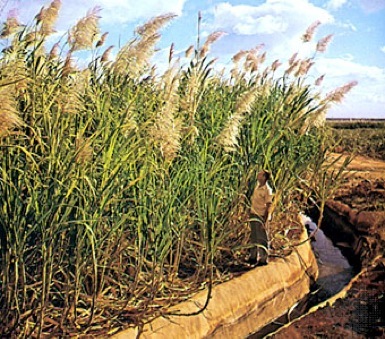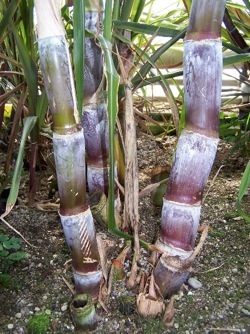Saccharum officinarum: Sweet Wild Weed
Among the edible wild plants on this site are a few escaped fruit trees and ornamentals that have become naturalized. Let’s add another: Sugarcane.
I’ve grown sugar cane for several years in my yard, neglecting it actually. It grows happily just the same despite the fact I am more than 200 miles north of south Florida and on a dry hill. So that is the first surprise about sugarcane or Saccharum officinarum. It’s a tropical and subtropical plant, found from Florida to Texas as well as Puerto Rico and Hawaii. One does encounter it growing in the wild. It looks like very tall corn that has mated with bamboo.
Sugarcane is actually a grass, a big grass — note the man in the picture above — and a perennial. There are a half dozen to three dozen species — botanists can’t agree –but that is kind of forgivable. Grasses are notoriously difficult to sort out, even when you know what it is. If you think it’s tough identifying mushrooms, try grasses for a real challenge.
Let me give you two estimates which as first would seem wrong. There are about 195 countries in the world, and about 195 countries grow sugar cane. That’s can’t be because places like Canada and Sweden don’t grow sugarcane. There is a two part explanation. The official number of countries is usually based on the membership in the United Nations. But several countries are not in the United Nations. Also sugar producers call some places countries that are not really countries, such as Puerto Rico and Bermuda. So two different measuring standards come up with the same answer — 195 — but their list of “countries” would be slightly different.
And while sugar cane is really mostly sugar — it is one of the most efficient plants there are — that’s not always a bad thing. In fact, sugarcane was included in military survival manuals because it is nearly impossible to misidentify and it does provide portable energy. You can use a stalk of it (a cane) as a walking stick and for food. You chew the end but spit out the fiber called bagasse (bah-GAS.) Once dry, bagasse burns well.
The clear sugar sap after processing is brown sugar, hence brown sugar is less processed sugar. Then it is bleached white. Also one can never get all of the sugar out of the sap and that becomes molasses, one of my grandmother’s preferred sweetener. She never used white sugar in her life. Any time anything called for sugar in went the molasses.
Sugarcane is probably from the area of India originally. Granular sugar was mentioned in writing some 5,000 years ago. It got to the Mediterranean Basin around 800 AD. Within 200 years there was hardly a village there that was not growing sugar cane. A sweet tooth is the one craving humans are born with. Sugarcane came to the New World some five hundred years later where it played a significant and controversial role, and still does.
Historical fact: Sugar was one of the first pharmaceutical ingredients, a sweetener to mask bitter medicine, hence the lyric… “a little bit of sugar helps the medicine go down.” There are generally three kinds of sugar cane grown, “chewing cane” “crystal cane” and “syrup cane.”
Saccharum officinarum (SAK-har-um of-fee-shee-NAR-um) means “sugar of the shops.” Officinarum comes from Latin and the Romans. Government-approved food and medicine in the Roman Empire were sold in designated shops. It was a standard of quality. Thus something sold in a shop was what we would call the authorized version, or the official version, the real McCoy. (See my article on Palmetto Weevils.)
Green Deane’s “Itemized” Plant Profile
IDENTIFICATION: Giant grass, eight to 20 feet, resembles corn, solid, jointed, juicy stalks, one to two inches thick, tough. Leaves three feet or more long, two to 2.5 inches wide, thick midrib, fine sharp teeth on the edges. Spikelet are white, hairy, plume like, two to three feet long. Can grow straight up or fall over.
TIME OF YEAR: This year’s sugar cane is usually harvested in November, but in a wild stand, nearly year round.
ENVIRONMENT: Moist, low areas as well as abandoned cultivations particularly in the Everglades.
METHOD OF PREPARATION: Stems are peeled and chewed for the juice. Or, they can be peeled, crushed and boiled for the syrup. Once a sweet syrup is obtained, or sugar, it can be used for many things, from making wine to fuel.



